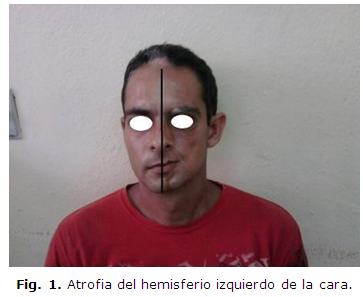Parry-Romberg syndrome
Keywords:
Facial hemiatrophy/diagnosis, Subcutaneous fat/pathology.Abstract
Parry-Romberg syndrome, also known as progressive hemifacial atrophy, is a weird neurocutaneous syndrome of unknown etiology. The main characteristics are atrophy of soft tissues, and sometimes the bone, in one half of the face or the frontal side of the head, without facial weakening. Current studies consider this pathology likely hereditary, since affected people are known belonging to a same family. This work describes an affected individual coming with his daughter also with a facial asymmetry. It is important the following of these patients and their families to complete a diagnosis permitting to precautiously take measures.
Downloads
References
1. Chokar G, Cerase A, Gough A, Hasan S, Scullion D, El-Sayeh H, Buccoliero R. A case of Parry-Romberg syndrome and alien hand. J Neurol Sci. 2014 apr 13[citado 11 feb 2014]; 341(1-2). Disponible en: http://www.ncbi.nlm.nih.gov/pubmed/24793509
2. Moratalla Jareño T, González Alonso V, López Blanco E, Domenèch Tárrega A, Carazo Palacios E, Gutiérrez Ontalvillas P. Use of lipofilling in pediatric patients. Cir Pediatr[Internet]. 2013 oct[citado 5 ene 2014]; 26(4):189-94. Disponible en: http://www.ncbi.nlm.nih.gov/pubmed/24645245
3. Ehmann D, Riyaz R, Greve M. Central retinal artery occlusion in a child with Parry-Romberg syndrome. Can J Ophthalmol[Internet]. 2014 feb[citado 5 ene 2014]; 49(1): e9-10. Disponible en: http://www.ncbi.nlm.nih.gov/pubmed/24513383
4. Moloney G, Lehman A, Shojania K, Ross M, McCarthy M. Corneal findings in Parry-Romberg syndrome. Can J Ophthalmol[Internet]. 2014 feb[citado 5 ene 2014]; 49(1):e2-5. Disponible en: http://www.ncbi.nlm.nih.gov/pubmed/24513374
5. Janowska M, Podolec K, Lipko-Godlewska S, Wojas-Pelc A. Coexistence of Parry-Romberg syndrome with homolateral segmental vitiligo. Postepy Dermatol Alergol. [Internet] 2013 dec[citado 11 feb 2014] 30(6): 409-11. Disponible en: http://www.ncbi.nlm.nih.gov/pmc/articles/PMC3907907/
6. Raina UK, Seth A, Gupta R, Goel N, Gupta A, Ghosh B. Parry-Romberg syndrome studied by spectral-domain optical coherence tomography. Ophthalmic Surg Lasers Imaging Retina[Internet]. 2014 jan 1[citado 11 feb 2014]; 45: E1-4. Disponible en: http://www.ncbi.nlm.nih.gov/pubmed/24477334
7. Kar S. Parry Romberg syndrome. J Assoc Physicians India[Internet]. 2013 feb[citado 16 dic 2013]; 61(2):134. Disponible en: http://www.ncbi.nlm.nih.gov/pubmed/24471252
8. Vedwas C, Urbanek RW. Hemifacial atrophy. Dermatol Online J[Internet]. 2013 dec 16[citado 11 feb 2014]; 19(12): 20717. Disponible en: http://www.ncbi.nlm.nih.gov/pubmed/24365008
9. Tang XJ, Liu W, Yang B, Shi L, Yin L, Zhang ZY. Parry-Romberg syndrome with rare maxillofacial deformities: A report on two cases. J Craniomaxillofac Surg[Internet]. 2013 nov 26[citado 11 feb 2014]; 42(6): 780-3. Disponible en: http://www.ncbi.nlm.nih.gov/pubmed/24359863
10. Sande A, Risbud M, Kshar A, Paranjpe AO. Progressive hemifacial atrophy. Dent Res J (Isfahan)[Internet]. 2013 jan[citado 11 feb 2014] 10(1):108-11. Disponible en: http://www.ncbi.nlm.nih.gov/pubmed/23878573
11. Xu M, Yang L, Jin X, Xu J, Lu J, Zhang C, Tian T, Teng L. Female predominance and effect of sex on Parry-Romberg syndrome. J Craniofac Surg[Internet]. 2013 jul[citado 11 Feb 2014]; 24(4): 1195-200. Disponible en: http://www.ncbi.nlm.nih.gov/pubmed/23851768

Published
How to Cite
Issue
Section
License
Authors who have publications with this journal agree to the following terms: Authors will retain their copyrights and grant the journal the right of first publication of their work, which will be publication of their work, which will be simultaneously subject to the Creative Commons Attribution License (CC-BY-NC 4.0) that allows third parties to share the work as long as its author and first publication in this journal are indicated.
Authors may adopt other non-exclusive license agreements for distribution of the published version of the work (e.g.: deposit it in an institutional telematic archive or publish it in a volume). Likewise, and according to the recommendations of the Medical Sciences Editorial (ECIMED), authors must declare in each article their contribution according to the CRediT taxonomy (contributor roles). This taxonomy includes 14 roles, which can be used to represent the tasks typically performed by contributors in scientific academic production. It should be consulted in monograph) whenever initial publication in this journal is indicated. Authors are allowed and encouraged to disseminate their work through the Internet (e.g., in institutional telematic archives or on their web page) before and during the submission process, which may produce interesting exchanges and increase citations of the published work. (See The effect of open access). https://casrai.org/credit/


